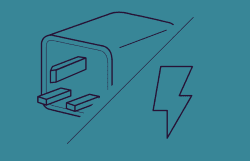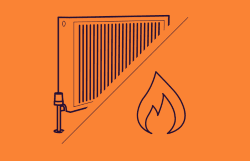Introduction
Energy Solutions also works with water suppliers. In order to help customers make a decision regarding whether or not they should switch to a new supplier, Energy Solutions aims to help them understand how water bills work. From this guide, you can find out what various elements constitute water bills and how they are calculated. Based on that information you will be able to estimate how much you will have to pay for your business’s water bill.
How business water bills and sewerage charges are calculated?
Water bills
In the UK water companies are allowed to determine their own ways of charging businesses for water and sewerage services. The charges usually depend on how much water the non-household customer has used, and how much wastewater and trade effluent it discharged.
The water bills are calculated differently for businesses that have water meters and those that don’t.
Businesses that have a water meter installed on their premises:
- Will need to pay a standing charge, which can be different for each meter.
- The standing charge is based on the size of the meter.
- Businesses will need to pay a set charge per cubic metre of water used.
Businesses that do not have a water meter installed:
- The charges will be calculated as for domestic customers who do not have the meter.
- The bill is not based on how much water the business has used but consists of a fixed charge and a charge related to the rateable value of the business’s premises.
If you are a small business, the charge per unit of water used is likely to be the same as for regular, non-business households. There are also small additional charges applied for connection, customer service and billing costs. The amount can be different for each water supplier.
Sewerage charges
The charges for sewerage services include the treatment and collection of several types of wastewater. They can be found in the table below.
| Type of wastewater | Description |
| Surface water drainage | rainwater that goes from your business’s premises into the public sewer |
| Highway drainage | water that runs off roads and pavements |
| Foul sewage | domestic wastewater like water from toilets |
| Trade effluent | any water used for business, trade, or industrial purposes |
Charges for foul sewage and trade effluent are calculated based on how much has been discarded. They also depend on the strength of the trade effluent. When it comes to highways and surface water drainage, water companies in the UK have many different approaches to determining charges for them.
If you believe that your business does not produce these types of wastewater you might be available for a reduction in your water and sewerage charges, subject to being able to prove it.
Water and sewerage tend to change each year. If you think another water supplier offers more competitive prices, you are normally allowed to switch to their services.
What is Ofwat?

Ofwat is the governmental department responsible for regulating the water industry. It was established in 1989 after the privatisation of water and sewerage industry in England and Wales. It limits water prices for small businesses and domestic clients. Large businesses have their water bills regulated differently but Ofwat works as an economic regulator and ensures that prices they need to pay are fair. When you compare water suppliers you might notice that their prices are different. Ofwat makes sure that despite these differences the charges are just. To read more about Ofwat click here.
How does Ofwat regulate charges?
If your business uses less than 50Ml, the chargers will be subject to price limits set by Ofwat.
If you use more than 50Ml water, the charges won’t be subject to price limits but the difference between charges for large users and smaller households cannot discriminate the former.
Customers can choose one of the multiple water suppliers. Each of them can have different prices and different policies. Your bill can be different each year as water and sewerage charges are adjusted annually. Nevertheless, Ofwat analyses the charges and varifies whether they are within the price limits set by them.
If Ofwat suspects a water supplier’s prices are not fair or they are misreporting their performance, Ofwat can start an investigation. If the suspicions prove to be true, the supplier will be fined them and will have to give the money back to customers. As illustrated by the graphic below, that was the case with Southern Water.
What different tariffs are available?
There are several types of water tariffs you can find. The best one for your business depends on how much water you use and on what your water use habits are. Below you can read about different tariffs that water suppliers often offer.
- Large or intermediate tariffs
Water bills for large and intermediate users are calculated differently than bills for small businesses. If your business uses more than a certain amount of water, usually 50,000 cubic metres (m3) of water or more each year, you can apply for a large or intermediate tariff. These tariffs are for non-household premises using high volumes of water, and they might be a more cost-efficient solution than paying the standard rate.
These types of tariffs consist of:
- standing charge
- volumetric rate (price per unit of water used)
Some of the large use tariffs will have an additional fixed charge and a lower price per unit of water used. Some will have lower rates for all water consumption once you’ve reached a certain limit of water used. These tariffs are composed like that to prevent businesses from using more water only to qualify for the tariff. They aim to encourage lower water use.
Water supplier can offer different large use tariffs, so if your business uses a lot of water you should ask them about these rates.
- Seasonal tariffs
Some water suppliers operate peak and off-peak seasons That allows businesses that use less water in the summer months than during winter to get seasonal tariffs. They have a rate that is higher in the summer and a discounted rate in winter. Water companies that allow businesses to apply for seasonal tariffs usually read water meters at the same time each year as seasonal tariffs are annual tariffs. Businesses can normally only use this tariffs if they already have a water meter installed.
- Subscribed demand tariffs
Subscribed demand tariffs are a great choice for businesses that know exactly how much water they will use. If you are able to forecast what your business’s daily demand for water will be, switching to this type of tariff might help you lower your water bill.
If you’d like to use this type of tariff, before the start of the billing year, you have to let your water supplier know what your predicted maximum daily demand will be.
A subscribed demand tariff is made up of several things that you can find in the table below.
| Rate | Expressed In | How it is Calculated |
|---|---|---|
| annual maximum demand charge | £ per megalitre per day | based on your maximum daily demand |
| usage rate | pence per cubic metre | applied to the amount of water used daily up to what you listed as your maximum daily demand |
| penalty rate | pence per cubic metre | applied to water used above the maximum daily demand reported earlier |
- Interruptible tariffs
Interruptible tariffs allow you to get lower water charges, but if you pick them you have to be prepared for occasional interruptions to your water supply. If you think you can create a plan to efficiently manage the interruptions and they won’t negatively affect your business, this type of tariff is a good way to save money on water bills.
Before you can sign a deal for this tariff, water suppliers have to check whether your business can deal with supply interruption. That’s why they might have to carry out a test interruption.
Charges for your own water supplies
If your business uses alternative water sources and you have your own supplies of water, you will need some water from the supplier as a protection in case your supplies fail. Your own supplies are known as standby supplies.
Water companies apply two charges to standby supplies:
- a volume charge expressed in pence per m3, which applies how much water you reserved over the curse of a year
- an individual capacity charge expressed in £ per megalitre per day, which is based on the maximum daily demand you notified the supplier about
How is non-potable water charged?
Most domestic customers get supplies of water that is of drinking quality. That kind of water is referred to as potable water and it can be safely used to drink or cook. Some water supplies give industrial customers the option to get non-potable water supplied. If your business uses water for industrial purposes, you could consider using non-drinkable water as it’s cheaper.
Non-potable water is normally charged for in the same way as water that is of drinking quality. Nevertheless, the cost per cubic metre for this kind of water tends to be lower. That’s because non-potable water does not have to meet strict health standards.
Non-standard charges
Some water supplies will include additional charges that are not normally included in the tariffs. These charges do not refer to the amount of water used but include services that the company provides. Examples of non-standard charges are:
- Fees for reconnection
- Water meters installation
- Testing water meters
- Installing hydrants
- Standpipe hire
Ofwat doesn’t regulate these charges but it monitors them to ensure they are fair. If you think your water supplier is overcharging you, you can make a complaint to Ofwat and they will start an investigation into that. The infographic below outlines the procedure that Ofwat follows when dealing with customers’ complaints.
If you want to make a complaint about your water supplier or sewerage company or want to read more about the process click here.




